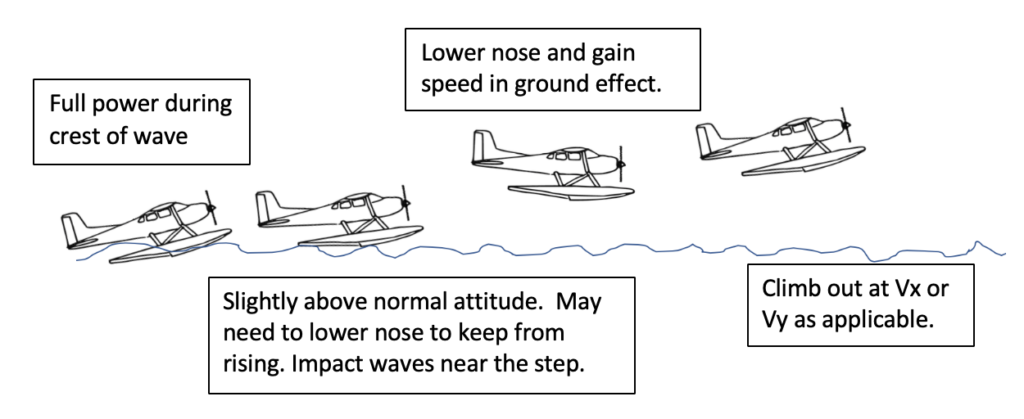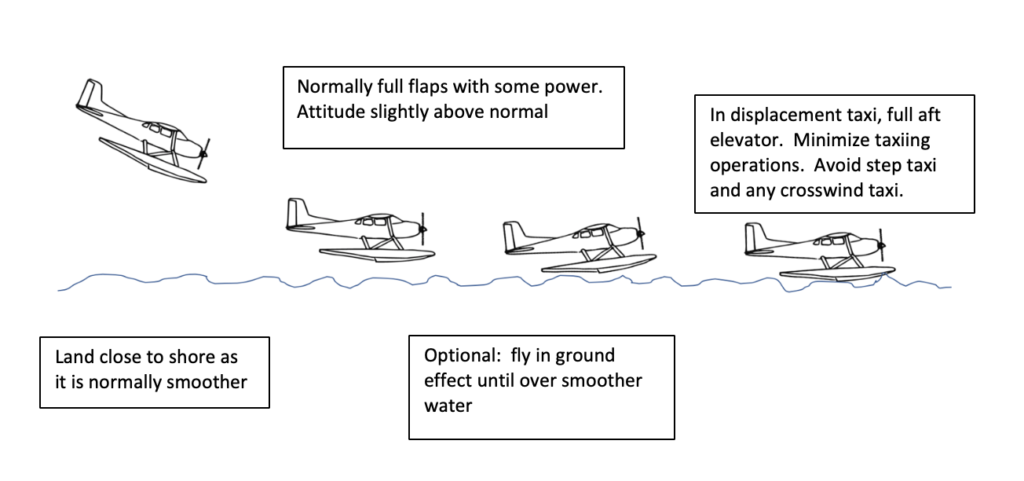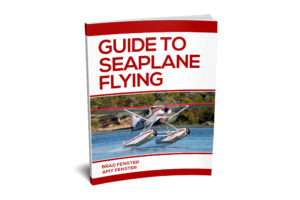Rough Water Takeoff/Landing
Rough water landings place a lot of stress on the airframe and float structure. The main intent is to minimize the stress on the aircraft. To do this, take off as quickly as possible and land at the slowest possible speed. It will become apparent with experience when to perform a rough water takeoff. Rough water conditions include any increase in wave height over normal conditions. However, limit operations when the wave height becomes excessive. The takeoff and landing technique, including wave-size limitations, are below. Conducting a rough water technique in normal conditions does not hurt anything. However, conducting a normal takeoff or landing in rough water places extreme stress on the aircraft. If in doubt about the conditions, use the rough water technique.
To minimize the likelihood of rough water, a protected cove or harbor should be considered. In addition, the windward side of a lake will have smoother water. Conversely, the lee side of a larger body of water will have bigger waves as the wind has more time and distance to impact the waves.
As noted, rough water operations are difficult on the airframe structure, particularly the floats. Thorough inspections of the airframe and float structure should be performed if rough water operations are conducted frequently. The constant pounding will likely cause some rivets to leak, requiring more frequent pumping of the floats. Another significant area of concern is the engine mount. Engine mounts should be thoroughly inspected if rough water operations are conducted frequently.
With experience, the pilot will improve technique and understanding of what the aircraft is capable of handling. The wing loading, power loading and pilot technique play large roles in the aircraft’s ability to handle rough water. However, some general wave height guidelines are outlined in a later section.
Crosswind taxiing should be avoided. The aircraft should be kept perpendicular to the waves. Given the increase in wave size, crosswind taxiing can significantly rock the aircraft and allow wind to get under the upwind wing. A capsize is much more likely in rough water.
In rough water, taxiing in general should be minimized. The waves will likely cause a lot of water spray which hampers visibility and is damaging to the propeller. A crosswind taxi creates even more water spray.
Rough Water Takeoff Technique
The takeoff should be done directly into the wind in order to distribute the stresses evenly on both floats. In addition, a takeoff directly into the wind provides the shortest takeoff run, which minimizes the impact on the floats.
Power should be applied as the bows of the floats are at the bottom of a wave so that full power is reached while the float is riding up or cresting on the wave.
The attitude during the takeoff run should be slightly higher than normal. Maintaining it slightly higher will keep the bows from digging into the next wave. However, the attitude should not be excessively high or too much drag will be created and will increase the takeoff distance.
After impacting each successive wave, the aircraft attitude will likely increase. If not corrected by the pilot, the aircraft may stall after becoming airborne after impacting a wave. Or, the airplane will not gain enough speed to become airborne. As such, the pilot will likely have to give forward control pressure to maintain the pitch attitude. The floats should be slicing through the waves, not bouncing from wave to wave. The pitch attitude should be only slightly above that needed for a normal takeoff. The floats should be impacting the waves near the step, generally the strongest part of the floats.
If done correctly, the seaplane should become airborne quickly. The rough water has less hydrodynamic drag on the floats, and the strong winds provide additional lift at slower ground speed. Once airborne, the nose should be lowered slightly, and airspeed gained while in ground effect. During this time, ensure not to descend and contact the water.
An advanced technique can be tried with some aircraft. During the takeoff run, the flaps can be extended an additional 5-10 degrees. This is usually done in aircraft with manual flaps, such as the Cessna 180/185. Start with normal takeoff flaps and right before liftoff speed add the additional flaps. This increased lift will help get the aircraft airborne. However, there will be too much drag to climb out. The aircraft should remain in ground effect until the flaps are retracted to normal takeoff settings. This technique should be practiced with an experienced instructor.
Rough Water Landing Technique
As noted earlier, one of the key components of rough water operations is to minimize the stress on the aircraft. The stress is reduced by landing at the lowest safe speed and distributing the stress evenly by landing on both floats at the same time. Overall, the landing is similar in approach to a normal landing, with a few nuances. The pilot should:
- Land in the smoothest water possible. An option is to fly at a low level over the water and then reduce power to land on a smoother area. This practice is especially applicable if the rough water is caused by boats or vessels.
- Land directly into the wind using the maximum flaps recommended by the aircraft’s manufacturer. Landing at the lowest possible ground speed minimizes the amount of time the floats are impacting the waves.
- Land with both floats at the same time. There is a high stress load in rough water and this stress should be displaced on both floats and strut systems. The struts are not designed for significant side loads.
- Maintain an attitude slightly above normal pitch attitude on touchdown. This practice minimizes the likelihood that the floats will dig into the waves. However, if the nose is too high, the floats will bounce from wave to wave.
- Do not conduct a full stall landing. Some power should be carried on approach and final. The speed will be slightly higher but will keep the nose from being too high.
- Consider approaching with less than full flaps and increase speed in gusty conditions. The increased speed provides better aileron control. When in ground effect, when it is usually less gusty, increase the flaps and land. If full aileron control is needed in ground effect, it is better to go around and find a more suitable landing area.
- Be prepared for a go around. A go around should be completed if the waves or gusts make the landing unsafe. In addition, a go around should be conducted if the plane becomes airborne after hitting a wave or significant gusts remain while in ground effect.
- Reduce speed quickly upon landing to minimize the impact from the waves. As indicated by the rough waves, there is likely significant wind. The runout upon landing should be fairly brief.
- Apply forward elevator pressure after landing to keep the floats slicing through the water rather than riding up and bouncing from wave to wave.
- Apply full back pressure as the plane starts to settle into the displacement taxi. The bows of the floats must be kept from digging into the waves.
- Avoid step taxi in rough water. The impact from the waves causes significant stress on the airframe.
- Minimize taxi operations. With rough water operations, the size of the waves will likely cause water to spray over the floats and impact the propeller. The water spray will be more pronounced while taxiing in any crosswind.
- Taxi perpendicular to the waves during rough water. Taxiing parallel to the waves causes a significant rocking motion which could lead to capsizing and increases the water spray on the propeller.
Wave Size Limitation
When on the water, there are some general rules for when to consider ceasing operations. The size of the floats, wing loading, and engine power determine the size of the waves the seaplane is capable of handling. However, the size of the floats can be used as the primary gauge for the pilot to evaluate the size of the waves for a specific seaplane.
Wave height is in excess of ½ of the float height. When waves exceed ½ the float height it is potentially too much wave height for the size of the floats.
Less than two waves on the float at one time. With little contact, it can be rough and damaging to the floats, or the float could dig in and/or submerge.





